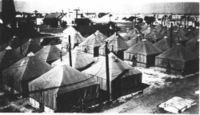Fort Screven
Fort Screven (1898-1944) - An Endicott Period Coastal Fort first established 18 Mar 1898 as Camp Graham by Capt. M.K Davis, Battery F, 1st U.S. Artillery. Named Fort Screven after BG James Screven, who was killed at Midway Church in 1778 during the Revolutionary War. Ceased to be a Coastal Artillery Post 27 Feb 1924 and was declared surplus 21 Oct 1944.


Endicott Period (1890-1910)
Part of the Harbor Defense of Savannah.
The first Endicott Period battery on Fort Screven was started in 1897 and was completed in Jul 1898, just before hostilities ceased in the Spanish American War. A total of four batteries were accepted for service in 1899, and one each in 1900, 1901, and 1904 for a total of seven Endicott Period batteries.
| Battery Click on Battery links below |
No. | Caliber | Type Mount | Service Years | Notes |
|---|---|---|---|---|---|
| Battery Habersham | 8 | 12" | Mortar | 1898-1900-1900-1942 | Four mortars removed in 1918 |
| Battery Garland | 1 | 12" | Barbette | 1898-1899-1899-1942 | |
| Battery Fenwick | 1 | 12" | Barbette | 1898-1899-1899-1942 | |
| Battery Brumby | 4 | 8" | Disappearing | 1897-1898-1899-1917 | Guns removed for service abroad 1917 |
| Battery Backus | 1 2 |
6" 4.72" |
Armstrong Armstrong |
1898-1898-1899-1920 1899-1900-1901-1920 |
Guns approved for scrapping 1919 |
| Battery Gantt | 2 | 3" | Masking Parapet | 1899-1900-1904-1920 | Guns approved for removal 1920 |
| Source: CDSG | |||||

World War I (1917-1918)
The disarming of the Endicott Period batteries began in 1917 with the removal four 8" guns from Battery Brumby for overseas service during World War I. In 1918 four mortar tubes from Battery Habersham were removed to provide more efficient operation and reduce manpower requirements. The guns from Battery Backus and Battery Gantt were scrapped as a part of the World War I post war disarmament push.
General Order Number 8, 27 Feb 1924, declared Fort Screven no longer a Coast Artillery post.
World War II (1941-1945)

The remaining guns from Battery Habersham and the guns from Battery Garland and Battery Fenwick were scrapped in 1942 during the first large scale scrap drive of World War II. By the end of 1942 there were no armed Endicott Period batteries.
Four 155mm guns on Panama mounts were placed in service in 1942 and remained in service until 1944.
During World War II Fort Screven became the training center for the U.S. Army Engineer Diving and Salvage personnel, training them to salvage and repair war damaged ports.
| Battery Click on Battery links below |
No. | Caliber | Type Mount | Service Years | Battery Cost | Notes |
|---|---|---|---|---|---|---|
| Battery 155 - Fort Screven | 4 | 155mm | Panama Mounts | 1942-1944 | $ ? | |
| Source: CDSG | ||||||
Current Status
Private property, many structures remain, batteries neglected or built over. No period guns or carriages in place.
|
{"selectable":false,"width":"500"} |
Location: Tybee Island, Chatham County, Georgia. Maps & Images Lat: 32.0212759 Long: -80.8439791 |
Sources:
- Roberts, Robert B., Encyclopedia of Historic Forts: The Military, Pioneer, and Trading Posts of the United States, Macmillan, New York, 1988, 10th printing, ISBN 0-02-926880-X, page 235-236
- Coast Defense Study Group, CDSG Press, CDSG Digital Library
Links
Visited: 19 Jan 2010
Fort Screven Picture Gallery
|
Click on the picture to see a larger version. Contribute additional pictures - the more the better! |
-
Fort Screven 1901 Officer's Quarters
-
Fort Screven Enlisted Mess

